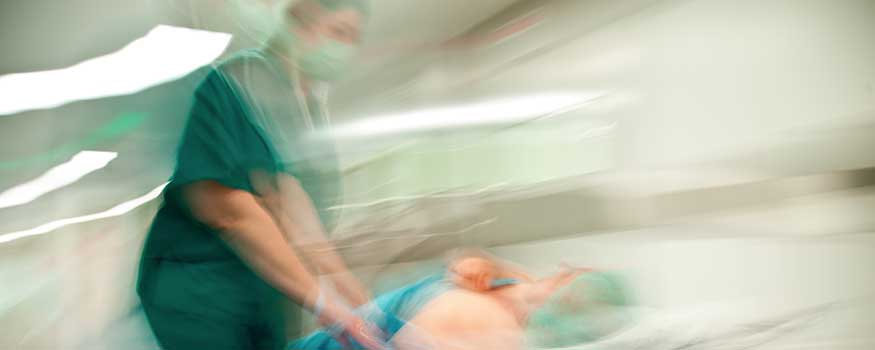Mary Meyer, a 20-year-old college student, is admitted to the medical unit with flulike symptoms including nausea, vomiting, headache, and fever. Her neck is stiff and sore. She reports feeling increasingly ill over the last 24 hours. Mary is admitted for treatment of dehydration and to rule out meningococcal meningitis. She is scheduled to undergo a lumber puncture in a few hours.
History and assessment hints
You observe a pale young woman who appears sleepy but is oriented. She has a 20-G I.V. in her right forearm infusing 0.9% sodium chloride at 125 mL/hr. Vital signs are blood pressure (BP) 132/89 mm Hg, heart rate 118 beats/minute (bpm), respiratory rate 24 breaths/minute, and oral temperature 101.8° F (38.8° C).
An hour later, you enter Mary’s room again. This time, you are unable to rouse her. You find that her pupils are 3 mm bilaterally and react sluggishly to light. Tests using painful stimuli yield a Glasgow Coma Scale score of 8: 1 point for not opening eyes to stimulation, 2 points for audible moaning to stimulation, and 5 points for localizing to the site of stimulation. Reassessment of vital signs reveals BP 155/93 mm Hg; heart rate 130 bpm; and respiratory rate 35 breaths/minute and labored.
You know that meningitis is a potential diagnosis. You recognize that decline in neurological status could be related to cerebral edema, which leads to an increase in intracranial pressure (ICP). You immediately call the Rapid Response Team (RRT) and then ask the charge nurse to contact the admitting physician.
On the scene
When the team arrives, Mary is nonresponsive to all stimuli; her pupils are 3 mm bilaterally and nonreactive. Mary’s BP is 168/70 mm Hg, heart rate 135 bpm, and respiratory rate 40 breaths/minute and labored. Rapid respirations and widened pulse pressure, characterized by high systolic and low diastolic pressures, indicate the Cushing response to increased ICP.
The physician intubates Mary with an oral endotracheal tube. He orders dexamethasone 10 mg. I.V. push and mannitol 50 g I.V. over 20 minutes. The RRT nurse uses an inline filter with the mannitol.
A stat computed tomography scan of the head without contrast is ordered and reveals cerebral edema.
Outcome
Mary is admitted to the intensive care unit. A neurosurgeon inserts a ventricular drain into the lateral ventricle of her brain to allow for cerebrospinal fluid drainage to decrease ICP and obtain a culture for testing. Diagnosis of meningococcal meningitis is confirmed and antibiotic administration begins.
In the following week, the physician removes Mary’s endotracheal tube and she is able to breathe on her own. She is awake and following commands but remains intermittently confused. The neurosurgeon removes the ventricular drain. Mary is afebrile and is transferred to a brain injury rehabilitation unit.
Education and follow-up
Meningococcal meningitis is cause by the bacteria Neisseria meningitidis. It can be spread from person to person in places where people in close quarters, such as college dorms. People who had been in close contact with the patient are treated prophylactically with antibiotics once a diagnosis is made.
Bacterial meningitis results in inflammation of the brain lining and the subarachnoid space, which leads to failure of the blood brain barrier and cerebral edema. As cerebral edema increases, ICP rises. The earliest sign is a decline in level of consciousness. Dexamethasone, a steroid, helps decrease the inflammation of the brain. Used in combination with antibiotics and mannitol, an osmotic diuretic, it can lower ICP to safe levels.
All children 11 to 12 years old should be vaccinated with a quadrivalent meningococcal conjugate vaccine. This vaccine protects against five serogroups of N. meningitidis that cause most meningococcal disease—A, B, C, W, and Y. Preteens, teens, and young adults identified as being at increased risk of meningococcal disease should be vaccinated with serogroup B meningococcal vaccine.
Laura Mcilvoy is an associate professor of nursing at Indiana University Southeast in New Albany, Indiana.
Selected references
Caple C, Schub T, Pravikoff D. Cinahl Information Systems, Quick Lesson: Meningitis, bacterial. June 12, 2015.
Driver C. Meningococcal disease: diagnosis and prevention. Primary Health Care. 2013;23(2):32-37.
Glimåker M, Johansson B, Halldorsdottir H, et al. Neuro-intensive treatment targeting intracranial hypertension improves outcome in severe bacterial meningitis: An intervention-control study. PLoS ONE. 2014;9(3):e91976.


















